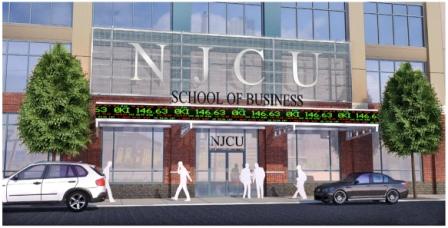Transportation Issue Looms with New Business School

Rendering of new business school. Provided by NJCU Press Office
March 28, 2015
The recent news that NJCU will move the School of Business to Harborside next
semester has raised student concerns over whether the school plans to offer transportation to
and from the main campus.
The new location — which is set to open in the of Fall of 2015 — is a 70,000-square-
foot space at Harborside Plaza 2 directly on the Jersey City waterfront near the Exchange Place
PATH and light rail stations.
Currently school officials have not confirmed whether shuttle service will be provided
for students who need to travel to the new building and back to take their general education
classes. (In previous interviews, Vice President of Finances Aaron Aska has said the cost
of running one shuttle bus to and from parking lots and the main campus is approximately
$57,000).
“As student body president I am concerned that there isn’t any transportation being
offered. Is there anything administration can do about that?” said Student Government
Organization President Alvert Hernandez. “I am concerned that the university can pay for
several high administrators’ salaries but cannot fund transportation for the student population.”
Hernandez voiced his concerns at several recent university meetings — with an audience
made up of professors, student representatives, the Vice President of Student Affairs John
Melendez, as well as President Sue Henderson.
“Is there a plan in place to partner with a private lot and subsidize parking? If not,
students that are taking general studies and then business classes will have to travel and incur
multiple fees, parking and gas,” Hernandez added.
A survey, outlining student views on campus matters, reflects that overall 10 percent of
students take the light rail, 26 percent take a bus, and 46 percent drive.
“In terms of the light rail and transportation, all that having to do [with travel], it is
something we are working on. We know we need to do something to meet the needs of our
students down at the waterfront,” said President Henderson. “We also have to consider the
people who drive. So we want to be inclusive in what we build or put together for the students.”
At a follow-up town hall meeting, Henderson said getting discounted light rail tickets
for students and possible discounted parking as another option is being explored.
“(At Harborside) we have the chance to work near the business personnel that can help
us grow in the specific area we want to work in,” said Harold Daniels III, president of the Black
Freedom Society and finance major.
Daniels, who will graduate in spring 2018 and lives on campus, said he hopes the
transition to the new business school will be smooth.
“As a resident student that drives and pays for campus parking, will parking be
available at the Harborside location?” Daniels asked.
A Gothic Times staff member took several trips from NJCU’s Gilligan Student Union
Building, walking to the West Side Ave. light rail and traveling to Harborside; the trips
averaged thirty minutes.
During an SGO council meeting President Henderson said the school is also in talks
with New Jersey Transit to offer discounted bus rides.
However some students don’t think that’s enough.
“As far as transportation I think the reason it keeps coming up is because it’s not as easy
as saying we’ll get on the light rail. I have gen-ed classes here; I have to go back and forth,
[and] then there’s also the trouble of how is this getting paid,” said Arijean Feliciano, NJCU
business society president and marketing major.
Feliciano negated Henderson’s claim that the majority of major classes students take are
in their senior and junior year and is pushing for the school to offer a way for students to travel
from the main campus to Harborside.
Feliciano also addressed a number of other concerns including whether the new
business school will offer a library resource area.
NJCU released a packet to the public entitled, “A Vision Of Impact” which details the
various aspects of the new business school, including the school’s plan to launch a campaign to
raise $20 million by 2020.
The school’s sole mention of anything transportation-related in the release is on page 3:
“Located footsteps away from the light rail station on Hudson Street, and adjacent to the PATH
line, the school of business is easily accessible for commuters and workers on both sides of the
Hudson River.”
The school signed a 20-year lease with Mack-Cali Realty in December and Daniel
Elwell, vice president for advancement, said the building is currently being renovated to
include new plumbing, electrical and IT setups.
“The total project cost for the capital-outfit is approximately $12 million and will
include state-of-the-art classrooms, simulated trading rooms, replete with Bloomberg terminals
and a reception area on the second floor,” according to a summary of upcoming projects
provided by Aska.
Aska added that the annual lease payments will range between $1.5 million to $2.5
million and these costs will be funded by projected enrollment growth for business graduate
and undergraduate programs.
Since 2010, business school enrollment has grown 15 percent overall and currently
consists of 850 students.
“Business is our academic area with the largest number of majors. The new Harborside
facility will ensure that we can physically meet enrollment demand,” said President Henderson
in a statement.
Where will students eat?
Absent from NJCU’s recent announcements, surrounding the business school, is
whether the business school will have a cafeteria.
At the senate meeting, Henderson said the school is considering all options, including
partnering with local Harborside businesses to lower the cost of food for students.
Daniels, a finance major who lives on campus, said he’s concerned over whether his
meal plan will help reduce his spending.
Feliciano, the business society president, noted at the town hall meeting that food costs
in Downtown can be costly and the availability of food options should have been established
with the new business school offering classes in a matter of months.
Ultimately, SGO President Hernandez hopes to assure students studying at the business
school (especially those who live on campus) won’t have to deal with the inconvenience of
complicated transportation and additional food costs.
The new business school was approved at a special board of trustees meeting last
October, along with a new 425-bed student residence hall on West Side Avenue, science
building renovations, renovations to the Margaret Williams Theater and the John J. Moore
Athletic Center.











